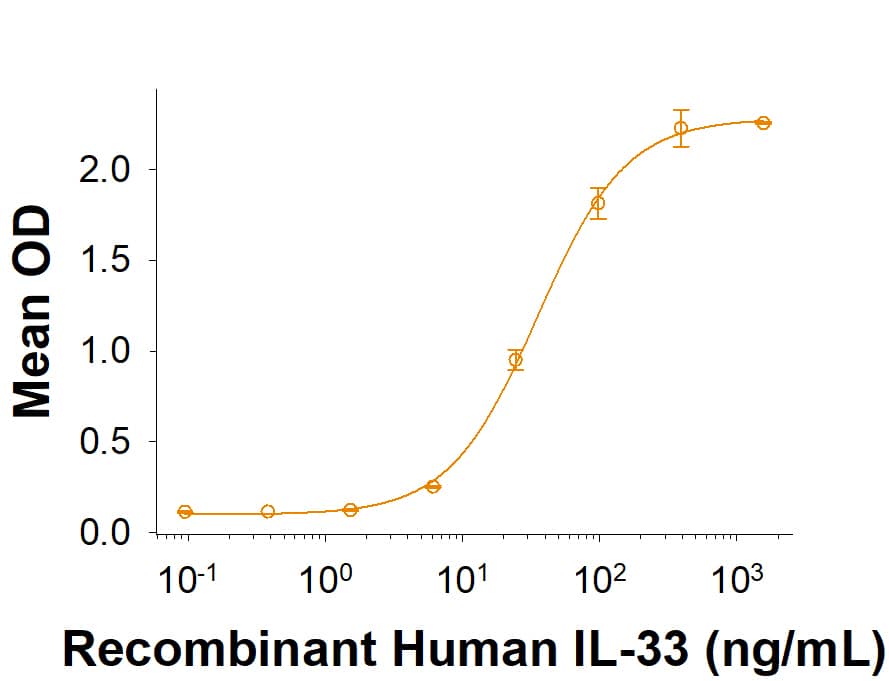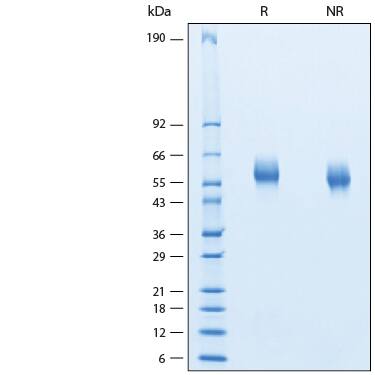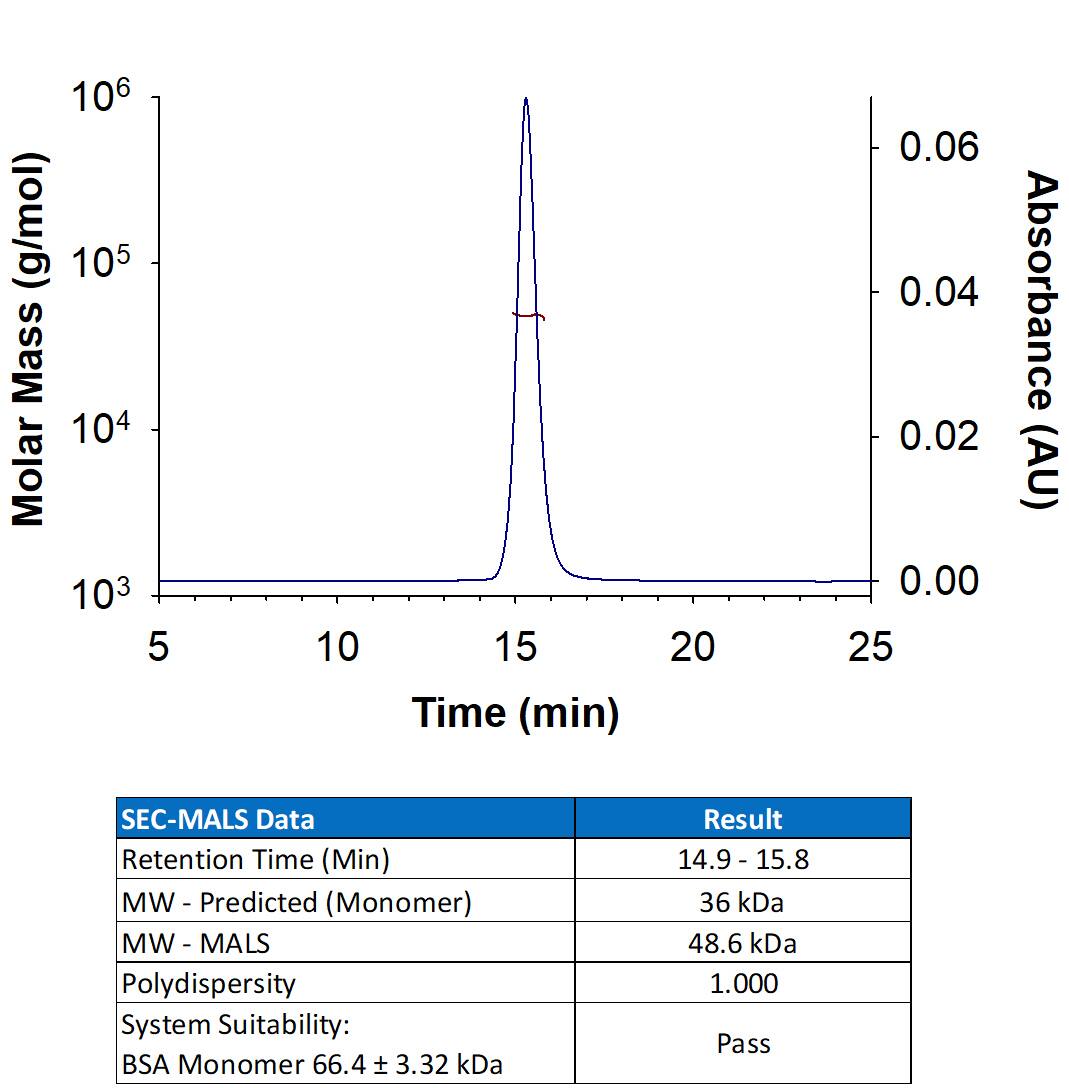Recombinant Human ST2/IL-33R His-tag Protein, CF
R&D Systems, part of Bio-Techne | Catalog # 11272-ST
Analyzed by SEC-MALS

Key Product Details
- R&D Systems HEK293-derived Recombinant Human ST2/IL-33R His-tag Protein (11272-ST)
- Quality control testing to verify active proteins with lot specific assays by in-house scientists
- All R&D Systems proteins are covered with a 100% guarantee
Product Specifications
Source
Human embryonic kidney cell, HEK293-derived human ST2/IL-33R protein
Lys19-Ser328, with a C-terminal 6-His tag
Lys19-Ser328, with a C-terminal 6-His tag
Purity
>95%, by SDS-PAGE visualized with Silver Staining and quantitative densitometry by Coomassie® Blue Staining.
Endotoxin Level
<0.10 EU per 1 μg of the protein by the LAL method.
N-terminal Sequence Analysis
Lys19
Predicted Molecular Mass
36 kDa
SDS-PAGE
55-62 kDa, under reducing conditions.
Activity
Measured by its binding ability in a functional ELISA.
When Recombinant Human ST2/IL-33R His-tag (Catalog # 11272-ST) is immobilized at 1 μg/mL (100 µL/well), Recombinant Human IL-33 (Catalog # 3625-IL) binds with an ED50 of 10.0-80.0 ng/mL.
When Recombinant Human ST2/IL-33R His-tag (Catalog # 11272-ST) is immobilized at 1 μg/mL (100 µL/well), Recombinant Human IL-33 (Catalog # 3625-IL) binds with an ED50 of 10.0-80.0 ng/mL.
Scientific Data Images for Recombinant Human ST2/IL-33R His-tag Protein, CF
Recombinant Human ST2/IL-33R His-tag Protein SEC-MALS.
Recombinant Human ST2/IL-33R His-tag (Catalog # 11272-ST) has a molecular weight (MW) of 48.6 kDa as analyzed by SEC-MALS, suggesting that this protein is a monomer. MW may differ from predicted MW due to post-translational modifications (PTMs) present (e.g. Glycosylation).Recombinant Human ST2/IL-33R His-tag Protein Binding Activity.
When Recombinant Human ST2/IL-33R His-tag Protein (Catalog # 11272-ST) is immobilized at 1 μg/mL (100 µL/well), Recombinant Human IL-33 (3625-IL) binds with an ED50 of 10.0-80.0 ng/mL.Recombinant Human ST2/IL-33R His-tag Protein SDS-PAGE.
2 μg/lane of Recombinant Human ST2/IL-33R His-tag Protein (Catalog # 11272-ST) was resolved with SDS-PAGE under reducing (R) and non-reducing (NR) conditions and visualized by Coomassie® Blue staining, showing bands at 55-62 kDa.Formulation, Preparation and Storage
11272-ST
| Formulation | Lyophilized from a 0.2 μm filtered solution in PBS with Trehalose. |
| Reconstitution | Reconstitute at 250 μg/mL in PBS. |
| Shipping | The product is shipped at ambient temperature. Upon receipt, store it immediately at the temperature recommended below. |
| Stability & Storage | Use a manual defrost freezer and avoid repeated freeze-thaw cycles.
|
Background: ST2/IL-33R
References
- Barksby, H.E. et al. (2007) Clin. Exp. Immunol. 149:217.
- Gadina, M. and C.A. Jefferies (2007) Science STKE 2007:pe31.
- Tominaga, S. et al. (1992) Biochim. Biophys. Acta. 1171:215.
- Li, H. et al. (2000) Genomics 67:284.
- Schmitz, J. et al. (2005) Immunity 23:479.
- Lecart, S. et al. (2002) Eur. J. Immunol. 32:2979.
- Brint, E.K. et al. (2004) Nat. Immunol. 5:373.
- Weinberg, E.O. et al. (2002) Circulation 106:2961.
- Sanada S. et al. (2007) J. Clin. Invest. 117:1538.
- Palmer, G. et al. (2008) Cytokine 42:358.
- Chackerian, A.A. et al. (2007) J. Immunol. 179:2551.
- Allakhverdi, Z. et al. (2007) J. Immunol. 179:2051.
- Verri, Jr. W.A. et al. (2008) Proc. Natl. Acad. Sci. 105:2723.
- Miller, A.M. et al. (2008) J. Exp. Med. 205:339.
- Hayakawa, H. et al. (2007) J. Biol. Chem. 282:26369.
Long Name
Interleukin 33 Receptor
Alternate Names
DER4, Fit-1, IL-1 R4, IL-1R4, IL-1RL1, IL-33 R, IL-33R, IL1R4, IL33R, Ly84, ST2L, ST2V, T1
Gene Symbol
IL1RL1
UniProt
Additional ST2/IL-33R Products
Product Documents for Recombinant Human ST2/IL-33R His-tag Protein, CF
Product Specific Notices for Recombinant Human ST2/IL-33R His-tag Protein, CF
For research use only
